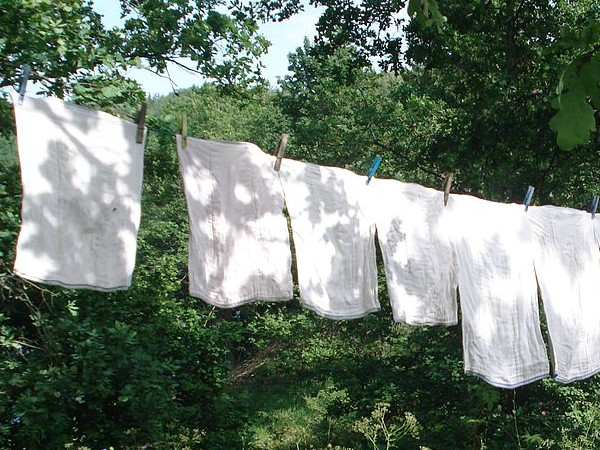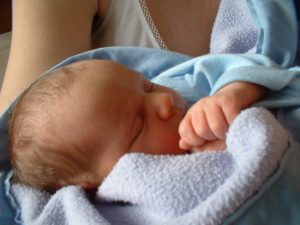Real nappies - introduction

Image: C K Klose, CC BY-SA 3.0
“Politicians and diapers should be changed frequently, and for the same reason.” – Eça de Queirós
What are real nappies?
They’re washable nappies often made from 100% cotton or other natural materials. Real nappies are reusable, unlike the alternative – disposable nappies, which are thrown away after use. There are lots of different makes, styles, patterns and colours to choose from, and they usually come with a waterproof outer, and sometimes liners to catch solids – either fabric and washable or paper and flushable.

Basic terry squares.
The main types are:
- terry squares – the simplest type. This is the traditional nappy, folded and pinned (or you can use a plastic ‘Nappy Nippa’-type fastener). You use them with a removable waterproof outer, and they are by far the cheapest option, and the easiest to dry;
- prefold – cotton rectangles folded to size and placed inside a cover; another cheap option;
- pocket or stuffed nappies – the ‘pocket’ comprises waterproof outer and absorbent inner, between which is stuffed a washable absorbent layer; work well, bit more expensive;
- shaped – absorbent material shaped like a disposable, fixed with velcro, poppers or nappy-nippa, and used with a waterproof outer; more expensive and take longer to dry;
- all-in-ones – the same as shaped nappies, but with a fixed outer layer; possibly the simplest to use, but take the longest to dry. You’ll need to get different sizes as your baby grows.

Washing at 60°C will kill all bacteria; it’s not necessary to wash at a higher temperature than that.
What are the benefits of real nappies?
Cost
No contest. The Women’s Environmental Network found in 2006 that using disposables over 2.5 years costs between £600-£900, and washables (including washing) £200-£350; and this detailed comparison in 2008 came up with figures of around £1600 for disposables and £400 for washables. And of course the cost benefits are greater if you use the same nappies for a subsequent child. They’re designed to be used for at least 2 babies.

Inserting absorbent material into a pocket nappy.
For the child
Using real nappies avoids the nasty synthetic chemicals in disposable nappies, such as polyacrylic acid (banned from tampons due to the link with toxic shock syndrome); tribulytin (damages the immune system and disrupts sex hormones); dioxins (carcinogenic); ethylbenzene (suspected respiratory toxin); styrene (suspected carcinogen); and many more. See here and here for more information.
What about nappy rash? Here’s a study published in the British Journal of General Practice that concludes that disposable nappies give little protection. There is no evidence at all that disposable nappies reduce nappy rash. It just means changing your baby more often, or you can use fleece washable nappy liners. They permit the urine to flow through and be absorbed but as they are not absorbent in themselves they keep it away from the baby’s skin, reducing the occurrence and severity of nappy rash.
Reusable / cloth nappies part 1: a tour of the different types of nappy.
Convenience
Well, disposable nappies are easier – but I’m assuming that you wouldn’t even be on this website if you didn’t care about what was happening to the environment. So you’re probably not the type to put ease above ecology. And people who’ve done it say it’s not that hard once you get into a routine. Another point about convenience – if you save time using disposables, how are you going to spend that time? Using real nappies means spending time with your baby, which you’re going to be doing anyway, but you’ll be doing something that is good for your baby, for the world it’s going to grow up in, and it will save you money – that you can spend on your baby. A no-brainer, surely? Using disposables is like throwing away your underwear at the end of every day instead of washing them – that’s convenient too.

Drying nappies and accessories on a clothes line.
Environment
The excess raw materials, energy, transport and waste involved in constantly manufacturing, distributing and dumping disposables increase what’s known as throughput, which is the source of all our ecological problems. Also, the chemicals and concentrated fecal waste from disposables in landfill sites leach into groundwater. This causes toxicity problems for many plants and animals, including ourselves, as 35% of our drinking water comes from groundwater. Real nappies are a clear winner, and there are even more environmental benefits if the nappies are made from organic cotton, and if the same nappies are used for a subsequent child.
However, an Environment Agency report in 2005 found very little difference in the environmental impact of real nappies v disposables. The report was immediately criticised – it claimed that people use double the number of nappies they actually do; they based energy consumption on old, low-efficiency washing machines; they assumed a wash temperature of 90°C rather than 60°C; plus they included the energy required to iron and tumble-dry nappies. But are people environmentally-aware enough to use washable nappies really going to iron or tumble-dry them?

Shaped nappy folded and fastened with a ‘nappy-nippa’.
Why the EA did this is open to debate – but in response to criticism, they produced another report in 2008 that concluded that the average carbon emissions for disposables until a child is potty trained came out at about the same – around 560 kg over two-and-a-half years – but with scope to reduce this figure by 200 kg with reusables, via behaviour change – i.e. not ironing, using reusables for more than one child (which they accepted is the norm), having an energy-efficient washing machine, washing with fuller loads, not washing above 60°C and not using tumble-driers. We think people who use reusables are much more likely to do all of these things. But still they only looked at shaped nappies, which are heavier than terries. And finally, the toxicity of the chemicals used in disposables wasn’t touched upon, and neither was the removal of habitat for the factories, car parks, roads etc for the perpetual manufacture and distribution of disposables. It’s not all about carbon emissions.
Reusable / cloth nappies part 2: questions answered.
What can I do?
It’s not really advisable to lecture new parents about how to bring up their nippers – it’s a stressful time, and you won’t necessarily find people at their most receptive to new ideas! But, if you’re trying for a little one, and you’re thinking that you’d like to do it in the greenest / healthiest / cheapest way you can, here are some tips.
You might be able to get a demo and some trial kit locally. Contact your local authority to ask what they provide. All babies are different so it might take you a while to see which nappy works best for you and your baby. Most real nappy providers offer tester kits and samples which are really useful for first time users.

All-in-one.
You’ll need about 20 nappies, plus various accessories. There are lots of places to get them from, locally or online, and here is a Which? review of resuable nappies. It should cost around £100-£250 to kit yourself out, depending on which type you choose, and about £1 per week to wash them. You can save even more money by getting your nappies second hand. See here and here.
They don’t need soaking – just rinse the nappies immediately after use, wring them out, then chuck them in a bin with a tightly-fitting lid, with a few drops of tea tree oil. Wait until you have about 10 nappies, then wash at 60°C, and dry on a clothes horse or a line outside. Availability of drying space is crucial. If you don’t have it, then using a tumble dryer negates any environmental benefits. And of course, please don’t do what the Environment Agency assumed you’re going to do and iron nappies!

Real nappies now come in a range of different styles, colours and patterns.
There’s even detailed information out there on the different ways to fold real nappies – see here.
If you want to be even more environmentally-friendly, use eco detergents, don’t use fabric conditioner (it makes the nappies less absorbent), switch to a green electricity supplier, and make sure your nappies get reused after you’ve finished with them.

Prefold nappy with cover.
You can use a nappy washing service – although this will completely wipe out the cost benefits, and also the environmental benefits, due to the trucking around of soiled and clean nappies – so we can’t really recommend this option any more than we would recommend disposables.

